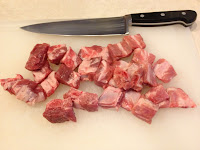What you'll need:
Marinade:
- 3 Tbsp soy sauce
- 1/2 Tbsp cooking wine
Dish Ingredients:
- 3/4 lb pork short ribs
- 2 cups deep frying oil (Peanut or canola works well here)
- 1 Tbsp stir frying oil (I prefer canola, but peanut or olive oil are good too)
- 1 sweet red bell pepper
- 1 green bell pepper
- 2 carrots
- 1/4 lb snow peas
- 1 can (8 oz) pineapple slices
Sauce:
- 2 Tbsp soy sauce
- 4 Tbsp sugar
- 3 Tbsp rice vinegar (I like Marukan brand "Seasoned Gourmet Rice Vinegar")
- 2 tsp corn starch
- 3 Tbsp cold water
- 1/2 Tbsp sesame oil
You can get pork short ribs at your Asian store, they will come in strips as shown here. If you don't have an Asian store, or your grocery store only has standard racks of ribs, you may be able to ask the butcher to cut them into 1" wide strips like this for you.
Cut the ribs apart by slicing between each bone, you will end up with small chunks like this. In a small bowl, combine the ingredients for the marinade, and add the pork. Mix well, cover, refrigerate, and allow to marinate for about an hour.
In the meantime, cut the vegetables and pineapple into small bite-sized chunks and set aside. You can add whatever vegetables you like - I find that sweeter varieties work best, like carrots and bell peppers. The more colorful, the more attractive the dish!
In a deep pot, heat the deep-frying oil until a tiny piece of vegetable will sizzle.
Gently place the spare ribs into the hot oil, taking care not to over-fill the pot. There should be some space between the ribs so you can stir them around a bit. Deep fry until the ribs are cooked all the way through, approximately 5 minutes.
Remove the spare ribs from the oil, and re-heat it until it starts to smoke. Place the spare ribs back into the pot, and deep fry again until they turn a golden brown, approximately 2 - 3 minutes.
Remove the spare ribs from the oil, and place on paper towels to drain.
In a small bowl, mix the first three sauce ingredients (soy sauce, sugar, rice vinegar), and set aside.
In a separate small dish, mix the corn starch and cold water and set aside.
In a large frying pan, heat the stir fry oil. Add the vegetables and pineapple, and stir fry over high heat until just cooked but still crispy, approximately 2 - 3 minutes. I usually add the heavier vegetables first (e.g. carrots) since they take longer to cook, then place the lighter vegetables (e.g. snow peas and bell peppers) and pineapple in last, so that they do not get over-done. Turn off the heat.
Add the sauce mixture (soy sauce, sugar, rice vinegar) to the frying pan and mix well until all the vegetables are coated.
Add the corn starch mixture to thicken the sauce, and drizzle with sesame oil, continue mixing well.
Add the spare ribs to the frying pan, and mix well.
Serve over hot steamed white rice, and enjoy!!!



















